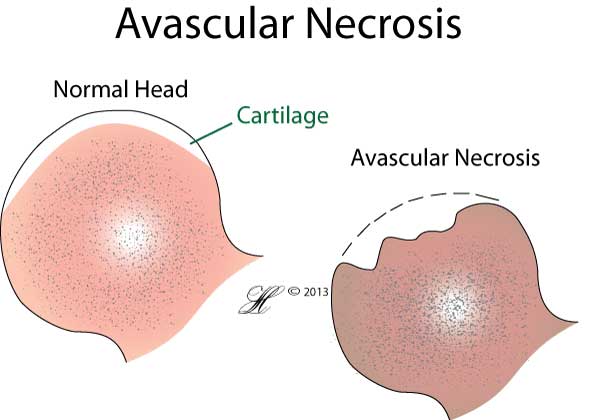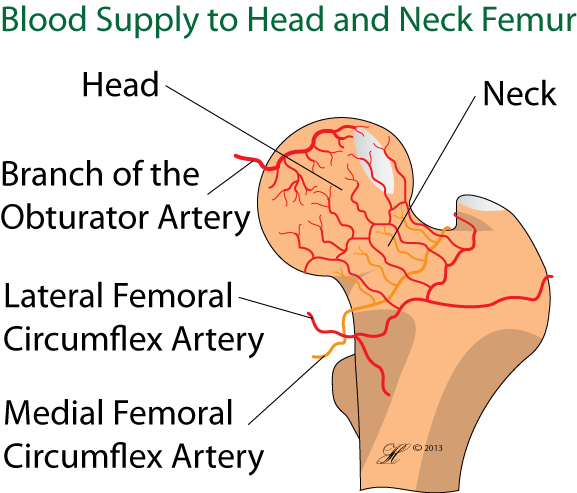Osteonecrosis of the hip, also called avascular necrosis, is a condition where the blood supply to the femoral head is disrupted. Your femoral head is located at the top of your thigh bone (femur) and forms part of your hip joint.
The lack of normal blood supply to the femoral head causes the bone to die. The bone is then weakened, predisposing it to collapse and osteoarthritis.

Symptoms
There are no symptoms in the early stages. As bone damage worsens, you may have the following symptoms:
- Pain in the joint that may increase over time, and will become very severe if the bone collapses
- Pain that occurs even at rest
- Limited range of motion
- Groin pain
- Limping
Causes
Osteonecrosis usually occurs when the blood vessels that provide blood to the femoral head are damaged, torn, or pinched. Without blood, the head of your femur dies and collapses leading to a deformity of the joint. This can lead to early osteoarthritis in the hip joint. Cartilage in the hip’s socket may also break down.
The list of causes for osteonecrosis is long and includes alcohol abuse, gout, Caisson disease (decompression sickness), renal osteodystrophy (kidney disease), sickle cell anemia, steroid use (corticosteriods), and trauma.
Sometimes, a cause cannot be found for osteonecrosis and is termed ‘idiopathic’ meaning there is no known cause.

Risk Factors
It is important to remember that most patients with the following risk factors never develop osteonecrosis, and many patients without identifiable risk factors do acquire the disease. The process is most likely multifactorial. Risk factors include:
- Trauma – Hip dislocation or fracture
- Cortisone use
- Conditions such as rheumatoid arthritis, sickle cell disease, myeloproliferative disorders, Gaucher’s disease, chronic pancreatitis, Crohn’s disease, Caisson’s disease, or systemic lupus erythematosus.
- Alcoholism
Investigations
Patients are typically asymptomatic early in the course of osteonecrosis and eventually have groin pain when walking.
A thorough history and physical examination will be performed to discover potential risk factors and to determine the extent of the problem.
The physical examination will involve the hip being flexed and rotated to check for pain.
X-rays will usually be taken as a first step of investigating the problem. Sometimes in early stages of osteonecrosis, the X-rays may appear normal in spite of the damage that may be present. In later stages of osteonecrosis, X-rays will show up characteristic signs due to the collapse of the bone caused by the osteonecrosis. Associated osteoarthritis may also be picked up on X-rays in long standing osteonecrosis of the hip.
There are other tests which may be performed which are more sensitive to the changes associated with osteonecrosis. These tests include
- Bone scanning – may be able to pick up early osteonecrosis
- MRI allows earlier diagnosis of osteonecrosis of the femoral head and allows determination of the exact stage and extent of the process without. When X-rays show changes in only one joint, MRI of both hips is indicated, not only to define clearly the extent of the disease in the symptomatic hip, but also to evaluate the asymptomatic (unaffected) hip. This can allow detection of the disease in the early stages when most treatments are more effective.
Complications
Osteonecrosis leads to death of bone in the affected area. This may then lead to collapse of the bone. If bone collapse occurs, complications include:
- osteoarthritis
- loss of joint function
- the need for a total or partial hip replacement
Treatment
Once diagnosed with osteonecrosis, patients should not weight bear on the affected hip and crutches should be used, minimizing the amount of movement.
Treatment depends on the extent of the damage to the hip joint due to the avascular necrosis.
If the femoral head has not collapsed, a procedure known as Core Decompression may be performed. This involves removing some of the dead bone which has formed due to the blood supply being cut off and filling the area with a bone graft. This may stop the femoral head from collapsing and improve the chance of the joint remaining viable. Other procedures may also be performed with a view to minimizing damage to the hip.
If osteonecrosis has already collapsed your hip, total hip replacement surgery (arthroplasty) may be necessary to eliminate your pain and give you better hip mobility. See section on total hip replacement.
Seeking Advice
Your Family Doctor (GP)
Your Family Doctor will be able to diagnose and help treat your problem. He or she will be able to
- tell you about your problem
- advise you of the best treatment methods
- prescribe you medications
- and if necessary, refer you to Specialists (Consultants) for further treatment
Prevention
The best way to prevent osteonecrosis of the hip is to avoid the risk factors, such as heavy alcohol intake.
